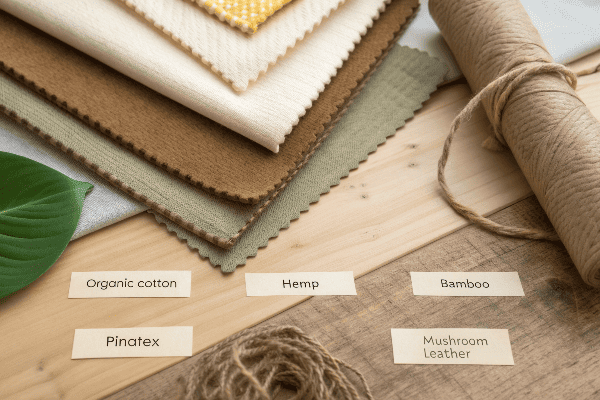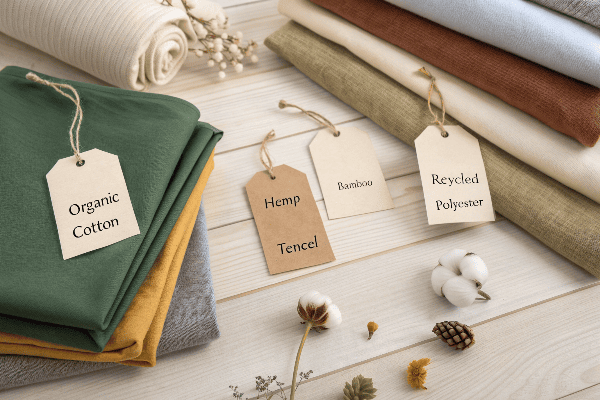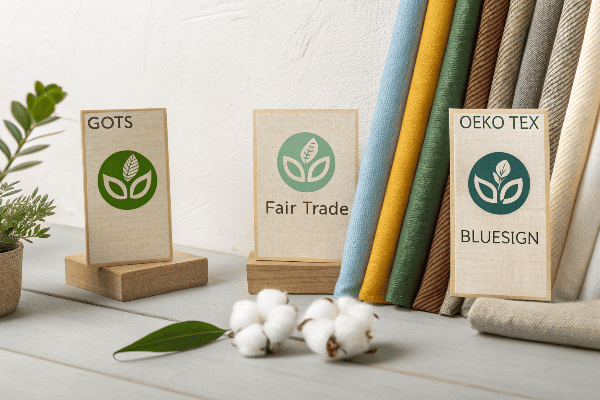The fashion industry faces mounting pressure to address its environmental footprint as consumers demand more sustainable options. Material selection stands at the crossroads of this challenge.
Sustainable fabrics represent the future of apparel manufacturing, with eco-friendly brands increasingly selecting materials based on reduced environmental impact, ethical sourcing practices, and circular economy principles rather than cost alone.

As a manufacturer with years of experience in the apparel industry, I’ve witnessed a remarkable shift in how brands approach material selection. Let me share insights into how the landscape is changing and what factors are driving these sustainable fabric trends.
Table of Contents
- What Are Natural Fiber Innovations Revolutionizing the Sustainable Fashion Industry?
- How Are Recycled Materials Transforming Eco-Friendly Apparel Production?
- Why Are Certification Standards Becoming Critical for Sustainable Fabric Selection?
- Conclusion
What Are Natural Fiber Innovations Revolutionizing the Sustainable Fashion Industry?
Traditional natural fibers like cotton and wool have dominated the textile industry for centuries, but their conventional production methods often harm the environment through excessive water usage and chemical treatments.
Innovative natural fibers including organic cotton, hemp, bamboo, and novel materials like pineapple leather (Piñatex) and mushroom leather are revolutionizing sustainable fashion by offering biodegradable alternatives with significantly reduced environmental impacts.

The Evolution of Traditional Natural Fibers
The journey toward sustainability begins with reimagining how we grow and process traditional fibers. In my manufacturing facilities, I’ve transitioned from conventional cotton to organic variants, witnessing firsthand the differences in environmental impact. Organic cotton uses 91% less water than conventional cotton and eliminates toxic pesticides that harm ecosystems and workers.
Hemp deserves special attention as a remarkably sustainable crop requiring minimal water, no pesticides, and enriching the soil it grows in. When I first introduced hemp fabrics to our production lines, I was impressed by their durability and natural resistance to UV damage and mold.
Emerging Bio-Based Materials
The most exciting developments are happening with innovative bio-based materials:
| Material | Source | Properties | Environmental Benefits |
|---|---|---|---|
| Piñatex | Pineapple leaf fibers | Leather-like, durable | Uses agricultural waste, biodegradable |
| Mycelium Leather | Mushroom roots | Customizable texture, strong | Grows quickly with minimal resources |
| Seacell | Seaweed | Soft, moisture-wicking | Carbon-negative, uses renewable resource |
| QMilk | Milk protein | Silky, antibacterial | Uses food industry waste |
Last year, I incorporated Piñatex into our accessories line and found that not only did it reduce our environmental footprint, but customers were genuinely excited about the innovative material. The texture and durability compared favorably to animal leather, opening new possibilities for cruelty-free designs.
How Are Recycled Materials Transforming Eco-Friendly Apparel Production?
The mountain of textile waste grows each year with fast fashion consumption, presenting both an environmental crisis and an opportunity for sustainable material sourcing.
Recycled materials, particularly rPET from plastic bottles and regenerated fibers from textile waste, are transforming apparel production by closing the loop on waste streams while requiring significantly less energy and resources than virgin material production.

Post-Consumer Recycled Materials
When I first started exploring recycled polyester (rPET) for our activewear line, I was skeptical about quality. However, after extensive testing, we found that modern recycled polyester performs identically to virgin polyester while using 59% less energy to produce. Each kilogram of recycled polyester prevents approximately 60 plastic bottles from entering landfills or oceans.
The technology for recycling has advanced significantly in recent years:
| Recycled Material | Source | Applications | Sustainability Impact |
|---|---|---|---|
| rPET | Plastic bottles | Activewear, outerwear | Reduces plastic waste, lower carbon footprint |
| Recycled Nylon | Fishing nets, carpet | Swimwear, athletic wear | Prevents ocean pollution, less oil usage |
| Econyl | Regenerated nylon waste | Performance clothing | Closed-loop production system |
| Recycled Cotton | Textile scraps | T-shirts, denim | Reduces landfill waste, less water usage |
Challenges and Solutions in the Recycled Material Supply Chain
Incorporating recycled materials1 isn’t without challenges. Initially, our supply chain struggled with consistent color matching across recycled batches. We implemented advanced color management systems and worked closely with suppliers to improve consistency.
Cost remains another barrier, with recycled materials typically commanding a 15-30% premium over virgin materials. However, as scale increases and technologies improve, this gap is narrowing. I’ve found that communicating the value proposition to brands helps justify the investment, especially when they can highlight these sustainable choices in their marketing.
Why Are Certification Standards Becoming Critical for Sustainable Fabric Selection?
In a market flooded with environmental claims, consumers and brands alike struggle to distinguish genuine sustainability from greenwashing without reliable verification methods.
Certification standards provide essential third-party verification of environmental and ethical claims, giving brands confidence in material sourcing decisions and consumers transparency about the products they purchase.

Key Certification Standards for Sustainable Textiles
When I advise brands on material selection, I emphasize the importance of recognized certifications:
| Certification | Focus Area | What It Verifies | Industry Recognition |
|---|---|---|---|
| Global Organic Textile Standard (GOTS) | Organic natural fibers | Organic cultivation, ethical production | Gold standard for organic textiles |
| OEKO-TEX Standard 100 | Chemical safety | Absence of harmful substances | Widely recognized for consumer safety |
| Bluesign | Chemical management | Environmental health & safety | Respected for holistic approach |
| Global Recycled Standard (GRS) | Recycled content | Verified recycled material content | Leading recycled material certification |
| Fair Trade Textile Standard | Social responsibility | Fair wages, safe conditions | Strong consumer recognition |
Our factory achieved GOTS certification three years ago, requiring significant investment in processes and documentation. However, this has opened doors to partnerships with premium brands committed to sustainability.
Balancing Multiple Sustainability Criteria
The challenge for brands lies in balancing various sustainability criteria. A material might excel in one area but underperform in another. For instance, organic cotton has excellent biodegradability but requires substantial water. Recycled polyester addresses waste issues but doesn’t biodegrade.
I’ve developed a comprehensive assessment framework for our material selection process that evaluates:
- Carbon footprint across the lifecycle
- Water consumption and pollution
- Biodegradability/end-of-life impact
- Chemical usage
- Social/ethical considerations
- Durability and performance
This balanced approach helps brands make informed decisions aligned with their specific sustainability goals rather than pursuing a one-size-fits-all solution.
Conclusion
The future of sustainable apparel relies on thoughtful material selection combining innovative natural fibers, recycled materials, and verified certification standards2. As manufacturers and brands collaborate more closely, we can accelerate the transition to truly sustainable fashion.


